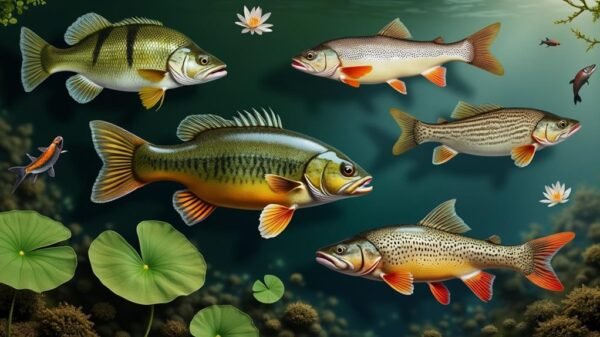To improve your trout fishing success, start by understanding their habitats—look for cool, clear waters near boulders and fallen timber. Next, choose your bait wisely; live options like worms or minnows work wonders, but experimenting with artificial lures can be exciting. Adapt to the water temperature; as it rises, trout feed near the surface. Keep seasonal patterns in mind—spring is active, while winter calls for patience in deeper waters. Lastly, use stealth; fish during low-light hours and cast accurately to reduce disturbances. There's so much more to discover on this topic that can enrich your fishing trips!
Understanding Trout Habitats
To catch trout effectively, you must understand their habitats. Trout thrive in freshwater ecosystems, frequently found in rivers, streams, and lakes. They prefer cool, clear waters rich in dissolved oxygen, often residing in areas with a robust current. Familiarity with the elements influencing freshwater fishing times can enhance your chances of success. Look for locations near boulders, fallen timber, or undercut banks—these structures offer shelter and attract their prey.
Trout are sensitive to thermal conditions, so monitor water temperatures closely. They favor temperatures ranging from 50°F to 65°F. Warmer waters can drive them to deeper, cooler zones or lead them to seek refuge in springs or tributaries.
Understanding seasonal shifts is also vital. In spring, trout are often near the surface during spawning. In summer, they retreat to cooler depths. In autumn, they become more active as they prepare for the winter months.
Choosing the Right Bait

Understanding trout environments lays the groundwork for choosing appropriate bait. When you're on the water, your bait can significantly impact your success, especially during prime fishing hours like dawn and dusk. Whether you're angling in a river, lake, or stream, opt for options that imitate trout's favored natural food sources. Here's a brief guide to assist you in selecting the ideal bait:
- Live Bait: Consider earthworms, minnows, or leeches. These options often prove irresistible to trout, particularly in their natural habitats.
- Artificial Lures: Experiment with brands like Mepps or Acme. Their movement in the water can lure trout, making them perceive it as an easy meal.
- Flies: If you're passionate about fly fishing, utilize dry flies or nymphs that mimic insects. Trout commonly feed on insects that drift onto the water's surface.
- PowerBait: This product, designed for stocked trout, comes in various colors and scents, stimulating the fish's sensory receptors.
Try different baits to discover what yields the best results on any particular day. The opportunity to test new methods enhances the thrill of trout fishing! Just remember, selecting the right bait can lead to an exhilarating catch. Enjoy your fishing adventure!
Adapting to Water Temperature

Water temperature significantly influences trout behavior and feeding habits, so modifying your fishing tactics can enhance your success. In colder conditions, trout become less active, preferring deeper, slower currents. Cast your line deeper to attract them, utilizing heavier sinkers or weighted lures to reach those depths. Just like the fishing prospects available in Florida's lakes and rivers, various trout species may respond differently to temperature shifts, making it essential to understand your target species.
As temperatures increase, trout exhibit more activity and begin feeding near the surface. This is an ideal time to switch to lighter lures and float your bait. Monitor the water temperature closely; sudden fluctuations can cause trout to become wary. If daytime temperatures rise, consider fishing early in the morning or later in the evening when trout are more inclined to bite.
Adjust your fishing locations accordingly as well. In cooler waters, seek out sheltered spots with structure, such as rocks or fallen logs. In warmer conditions, open areas with some current typically draw trout in. By being adaptable and observing how water temperature impacts trout behavior, you can significantly improve your chances of landing that coveted catch. Embrace the challenge and let your enthusiasm for trout fishing lead the way.
Recognizing Seasonal Patterns

Recognizing seasonal patterns is essential for enhancing your trout fishing endeavors. As the seasons progress, the behavior of trout shifts. Understanding the elements influencing freshwater fishing times can guide you in selecting the optimal moments to fish and adjusting your techniques, leading to greater success on the water. Here's a seasonal breakdown:
- Spring: As water temperatures rise, trout become more active and venture into shallower regions. Focus on using streamers and nymphs around the banks of rivers and lakes.
- Summer: Trout migrate to cooler waters. Target early mornings or late evenings for fishing. Employ lightweight, smaller lures or flies that imitate local insects, such as mayflies or caddisflies.
- Fall: This season represents prime fishing opportunities! Trout prepare for winter by feeding aggressively. Utilize larger baits and concentrate on deeper pools during daylight hours.
- Winter: Trout exhibit reduced activity. Locate them in deeper, slower-moving bodies of water. Opt for small jigs or live bait, and practice patience; the key to success in this season is stealth and stillness.
Employing Stealth Techniques

When engaging in trout angling, stealth serves as a crucial ally. Being quiet and meticulous on the water can significantly enhance your success. Trout, such as rainbow and brook varieties, are acutely responsive to disturbances, making your approach essential. Select early mornings or late evenings, known as the golden hours, when trout exhibit increased activity and reduced wariness. Recognizing the significance of underwater structures, such as rocks and aquatic plants, will assist you in pinpointing ideal fishing locations.
Next, focus on your equipment. Utilize lightweight, low-visibility tackle, like the Berkley Trilene Fluorocarbon line, to help prevent alarming the fish. Prioritize accuracy over distance when casting; a precise cast near structures, such as submerged logs or rocky outcrops, can entice trout without causing alarm.
Your movement plays a vital role as well. Avoid abrupt actions and instead, proceed slowly and intentionally. When wading in freshwater habitats, shuffle your feet to minimize sediment disturbance. If fishing from a kayak or canoe, drift silently to reduce noise levels. Lastly, observe your environment keenly. Be mindful of the wind direction and position yourself strategically to avoid sending your scent into the trout's vicinity.























